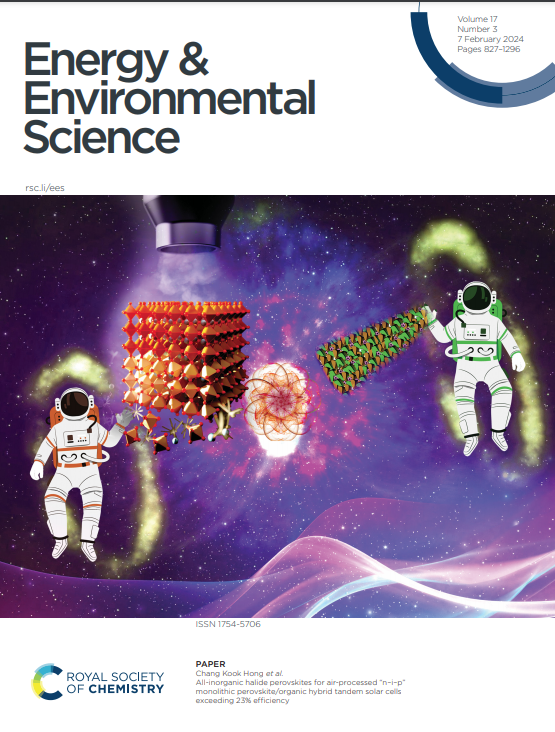Gradient fluoride, Zn-salt-rich hydrophobic interphase enabled by Zn-philic, H2O-phobic, anion-philic polymer 'skin' for anode-free solid Zn battery
IF 32.4
1区 材料科学
Q1 CHEMISTRY, MULTIDISCIPLINARY
引用次数: 0
Abstract
Manipulating ion solvation sheath behaviour is of great significance for alleviating dendritic growth, hydrogen production, and metal corrosion, thus achieving long-term stability of zinc ion batteries. Herein, we rationally design a Zn2+·O=C group-derived contact ion pair (CIP)/aggregate (AGG)-rich electrolyte with Zn-philic and H2O-phobic features through in situ polymerization of 3-methacryloxypropyl trimethoxysilane monomers. Being attributed with this unique electrolyte design, this "skin" enables the generation of gradient fluoride, Zn-salt-rich hydrophobic solid electrolyte interface (SEI) layer through increasing the ratios of ZnF2/ZnO in SEI layer. Moreover, the amounts of ZnF2 in inner SEI are higher than those in outer SEI. Considering the higher dendrite-suppressing and desolvation ability of ZnF2 instead of ZnO, the SEI exhibits excellent capability in suppressing the growth of Zn dendrite and restraining H2O-related side reactions. Owing to its unprecedented average modulus (71.25 GPa), the SEI effectively inhibits the external stress originating from dendritic growth, the undesirable volume expansion of Zn and the long-lasting anode/electrolyte side reactions. Consequently, at high depth of discharge of 34.2%, the symmetric cell maintains long-term stability for over 1000 h, and anode-free battery delivers superior performance with a high-capacity retention of 99.2% after 110 cycles.通过亲锌、疏水性、亲阴离子聚合物 "表皮 "实现富含氟化物和锌盐的梯度疏水相,用于无阳极固体锌电池
操纵离子溶解鞘行为对于缓解树枝状生长、氢气产生和金属腐蚀,从而实现锌离子电池的长期稳定性具有重要意义。在此,我们通过原位聚合 3 甲基丙烯酰氧基丙基三甲氧基硅烷单体,合理地设计出一种 Zn2+-O=C 基团衍生的接触离子对(CIP)/聚集体(AGG)富电解质,它具有亲锌和疏水的特性。由于采用了这种独特的电解质设计,这种 "皮肤 "能够通过增加 SEI 层中 ZnF2/ZnO 的比例生成梯度氟化物、富含 Zn 盐的疏水性固体电解质界面(SEI)层。此外,内 SEI 中的 ZnF2 含量高于外 SEI。考虑到 ZnF2 比 ZnO 具有更高的枝晶抑制和脱溶能力,SEI 在抑制锌枝晶生长和抑制与 H2O 相关的副反应方面表现出卓越的能力。由于其前所未有的平均模量(71.25 GPa),SEI 能有效抑制枝晶生长所产生的外应力、锌的不良体积膨胀以及持久的阳极/电解质副反应。因此,在 34.2% 的高放电深度下,对称电池可保持 1000 小时以上的长期稳定性,无阳极电池性能优越,110 次循环后容量保持率高达 99.2%。
本文章由计算机程序翻译,如有差异,请以英文原文为准。
求助全文
约1分钟内获得全文
求助全文
来源期刊

Energy & Environmental Science
化学-工程:化工
CiteScore
50.50
自引率
2.20%
发文量
349
审稿时长
2.2 months
期刊介绍:
Energy & Environmental Science, a peer-reviewed scientific journal, publishes original research and review articles covering interdisciplinary topics in the (bio)chemical and (bio)physical sciences, as well as chemical engineering disciplines. Published monthly by the Royal Society of Chemistry (RSC), a not-for-profit publisher, Energy & Environmental Science is recognized as a leading journal. It boasts an impressive impact factor of 8.500 as of 2009, ranking 8th among 140 journals in the category "Chemistry, Multidisciplinary," second among 71 journals in "Energy & Fuels," second among 128 journals in "Engineering, Chemical," and first among 181 scientific journals in "Environmental Sciences."
Energy & Environmental Science publishes various types of articles, including Research Papers (original scientific work), Review Articles, Perspectives, and Minireviews (feature review-type articles of broad interest), Communications (original scientific work of an urgent nature), Opinions (personal, often speculative viewpoints or hypotheses on current topics), and Analysis Articles (in-depth examination of energy-related issues).
 求助内容:
求助内容: 应助结果提醒方式:
应助结果提醒方式:


